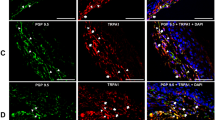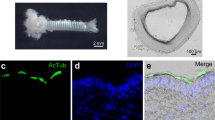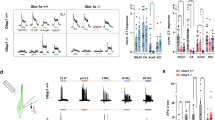Abstract
PREVIOUS investigations have shown that a variety of sensory receptors can be stimulated by the application of acetylcholine1, this sensitivity being enhanced in mechanoreceptors by the addition of 10−5 g/ml. physostigmine. Excitation by acetylcholine was blocked by tubocurarine or hexamethonium (10−7–10−5 g/ml.)2, but the response of the receptor to normal mechanical stimuli was unaffected by the presence of these blocking agents1,2, and Gray and Diamond conclude, therefore, that acetylcholine has no physiological function as an intermediary in the initiation of nerve impulses at sensory receptors1. Landgren et al.3, applying drugs to the surface of the frog's tongue, found, however, that high concentrations of anticholinesterases initially increased the spontaneous activity in the lingual nerve and afterwards blocked taste sensitivity. Tubocurarine also reduced the response of the taste buds to gustatory stimuli and these authors suggest that acetylcholine is concerned with the initiation of impulses at chemoreceptors.
This is a preview of subscription content, access via your institution
Access options
Subscribe to this journal
Receive 51 print issues and online access
$199.00 per year
only $3.90 per issue
Buy this article
- Purchase on Springer Link
- Instant access to full article PDF
Prices may be subject to local taxes which are calculated during checkout
Similar content being viewed by others
References
Gray, J. A. B., and Diamond, J., Brit. Med. Bull., 13, 185 (1957).
Diamond, J., J. Physiol., 130, 513 (1955).
Landgren, S., Liljestrand, G., and Zotterman, Y., Acta Physiol. Scand., 30, 105 (1954).
Trujillo-Cenoz, O., Z. Zellforsch., 46, 272 (1957). de Lorenzo, A. J., J. Biophys. Biochem Cytol., 4, 143 (1958).
Davis, H., Physiol. Rev., 41, 391 (1961).
Baradi, A. F., and Bourne, G. H., J. Histochem. Cytochem., 7, 2 (1959). Ellis, R. A., J. Histochem. Cytochem., 7, 156 (1959).
Pearse, A. G. E., Histochemistry ; Theoretical and Applied, second ed. (Churchill, London, 1960).
Duncan, C. J., Naturwiss., 51, 172 (1964).
Armett, C. J., and Ritchie, J. M., J. Physiol., 152, 141 (1960).
Furshpan, E. J., and Potter, D. D., Nature, 180, 342 (1957).
Author information
Authors and Affiliations
Rights and permissions
About this article
Cite this article
DUNCAN, C. Synaptic Transmission at Taste Buds. Nature 203, 875–876 (1964). https://doi.org/10.1038/203875a0
Issue Date:
DOI: https://doi.org/10.1038/203875a0
This article is cited by
-
Electron microscopy of taste buds of the rat
Zeitschrift f�r Zellforschung und Mikroskopische Anatomie (1965)
Comments
By submitting a comment you agree to abide by our Terms and Community Guidelines. If you find something abusive or that does not comply with our terms or guidelines please flag it as inappropriate.



